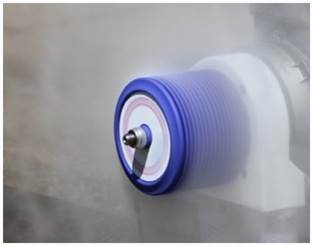Complex atomizer design made possible with 3D printing
Project name | Rotary Atomizer
Summary | Ricoh 3D worked alongside an industrial solution innovator to create the MicroMist™ Rotary Atomizer range – designed for demanding performance in harsh environments.
The problem | Future Engineering Developments are innovators in the field of atomizer devices for industrial processes. Director Steve Rix, inventor of the motor which many high-speed rotary atomizer manufacturers use today, approached Ricoh to explore how 3D printing could realise his ambitions for enhanced performance.
The solution | Rotary atomizers are used in the mining or building industry for dust suppression, odour control, humidification and adiabatic cooling.
They do this by atomizing and spraying high volumes of ultra-fine, low impact mist over the area.
Future Engineering Developments had come up with three innovative design solutions in the MicroMist™ range. The complex geometries of the designs meant it would have been very difficult, if not impossible, to manufacture them by using any method other than 3D printing.
Working alongside the design experts at Ricoh, 3D printing gave the designer the freedom to create exactly what was required for optimal part performance. The typical constraints of traditional single form manufacturing and the high cost of tooling were eliminated, resulting in a highly innovative solution.
Ricoh identified that the most effective material for this application would be polypropylene 3D printing as it lent itself to a low weight yet ultra-strong product, reducing the rotating mass of the atomiser by 50g compared to a Nylon 12 equivalent. Polypropylene’s high chemical resistance also gave this unique material the edge in this water-based application over conventional AM materials such as Nylon.
Furthermore, Ricoh 3D went the extra mile to apply for WRAS approval specifically for this project in order to qualify polypropylene’s resistance to water ingress, which means the water can be safely returned to the water table.
Ricoh 3D is now working with Future Engineering Developments to bring more new products from concept to manufacture.
Enrico Gallino, Materials Specialist at Ricoh, said: “This was 3D printing at its best and perfectly demonstrates how Ricoh can help customers shorten and optimise their product development cycle.”
Ricoh is looking forward to working with Steve on further innovative designs.
“This was 3D printing at its best.”

